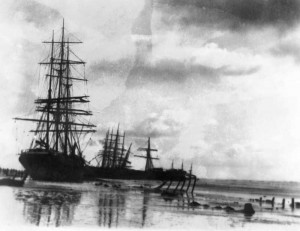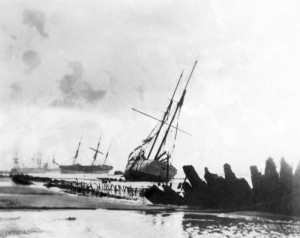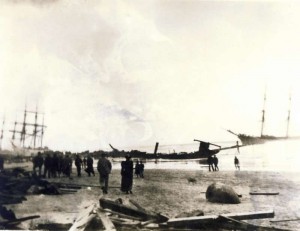“Never before in its history has this port suffered under such overwhelming disaster as we record today. On Sunday morning some 38 craft rode at anchor under the leaden sky. Heavy rains had fallen and the wind gradually rose until, as the shadows of evening hid the shipping from view, a fresh gale was blowing in from the south-east, which, as the midnight hour was reached, had developed in to a hurricane. As the turmoil of wind and wave continued, so the toll of ships mounted, until 18 vessels were aground, with a raging sea adding a high toll of human lives.”
 So read a report in the Eastern Province Herald in Port Elizabeth on 2 September 1902.
So read a report in the Eastern Province Herald in Port Elizabeth on 2 September 1902.
A gale force south easterly wind came up during the evening and night of Sunday 31 August 1902 when some 38 ships were riding at anchor in Algoa Bay. Huge waves battered the ships and several of them began to drift onto the bight of the bay.
The first distress signals sounded were gun shots which were heard just before midnight. The local rescue team, consisting mainly of a rocket brigade, went to the shoreline to see what they could do. In spite of their efforts the wind made it almost impossible to get lines to the distressed ships.
Four local men, Frank Gregory, A. I. McEwan, E. Hayler and John Mannie went out to attempt to get a line across but all were drowned in the attempt. Mothers and children were among those who succumbed in the raging seas.
 By the time the storm abated on the Tuesday there were perhaps 38 people known to have died and about 300 rescued. From that day funerals became a daily occurrence as more bodies were washed ashore. The victims were buried in Port Elizabeth's Southend Cemetery, where there is also a monument recalling the tragedy. On the monument are recorded the names of all the ships, those victims whose names are known, and the names of the local men who made the rescue attempt.
By the time the storm abated on the Tuesday there were perhaps 38 people known to have died and about 300 rescued. From that day funerals became a daily occurrence as more bodies were washed ashore. The victims were buried in Port Elizabeth's Southend Cemetery, where there is also a monument recalling the tragedy. On the monument are recorded the names of all the ships, those victims whose names are known, and the names of the local men who made the rescue attempt.
The disaster remains the largest marine disaster ever to hit South Africa – though there have been others with greater loss of life, never before or since have so many ships come to grief simultaneously on the treacherous South African coastline.
The list of ships which were beached that day included:
Oakworth – a British cargo sailing vessel of 1242 grt was on route from Port Pirie with a cargo of grain;
Emmanuel – was a German sailing barque of 1147 tons under the command of Captain Tuitzer on route from Port Pirie with a cargo of grain;
Coriolanus – was a German sailing barque of 978 tons. under the command of Captain Gotting on route from Wallaroo with a cargo of wheat;
Hans Wagner – was a German iron barque of 938 tons under the command of Captain Millman was on route from Melbourne with a cargo of grain;
Agostino Rombo – was an Italian sailing barque of 827 grt, en route from Buenos Aires with a cargo of forage under the command of Captain Vassho (Captain Vassho is listed on the Memorial SE cemetery at Port Elizabeth);
Waimea – Norwegian ownded ship was carrying a cargo of wood, with loss of Captain Oredorp and 7 crew on passage from Fremantle (Captain Oredorp is listed on the Memorial to the dead in the SE Cementary of Port Elizabeth);
Arnold – was a German iron sailing barque of 854 grt under the command of Captain Ahlars and carrying a general cargo
Sayre – a British cargo sailing barque of 735 grt was on route from New York with a general cargo ;
Nautilus – was a German sailing barque of 745 grt that dragged her anchor in the great storm of the 1st September 1902 and was wrecked at North End Beach, Algoa Bay. She was under the command of Captain Assing and on route from Adelaide with a cargo of wheat. Captain Assing and 11 crew lost. Their deaths are listed on the Memorial SE Cemetery, Port Elizabeth.
Content – was a Swedish sailing barque of 547 grt. under the command of Captain Gustafsen. She was on route from Rangoon with a cargo of rice when she was wrecked on North End Beach, Algoa Bay on the 1st September 1902.
Iris – a transport schooner of 522 tons;
Kimara – I have been unable to find out anything about this ship;
Hermanos – was a Norwegian sailing barque of 498 tons under the command of Captain Gunderson which was on route from Banbury with a cargo of wood;
 Thekla – was a German sailing 3 masted schooner of 350 grt on route from Mauritius with a cargo of sugar;
Thekla – was a German sailing 3 masted schooner of 350 grt on route from Mauritius with a cargo of sugar;
Constant – was a Norwegian sailing barque of 292 grt that was wrecked at North End Beach, Algoa Bay on the 1st September 1902 under the command of Captain Jacobsen when on roure from Rio de Janeiro with a cargo of coffee.
Clara – was a British Steam tug of 139grt;
Gabrielle – was a British sailing schooner of 78 tons on route from St. Johns with a cargo of wood;
Scotia – was a British cargo steamer of the Clan Line;
Countess of Carnarvon – was a wooden British steam tug of 38 tons;
Cavaliere Michele Russo – was an Italian ship of 1,529 tons on route from Newcastle, Australia with a cargo of Grain. 17 crew members died;
Inchcape Rock – was British full-rigged ship under the command of Captain Ferguson on route from Portland, Oregon.
My source for most of the above information about the ships involved is The Wreck Site.
The photos accompanying this post come from the collection of my late father, Murray McGregor. I do not have any idea of the name of the photographer.
For the identification of the photos I am grateful to FaceBook friends Valma Meier and Derek Watters.

Hi there.
I want to do a short documentary of this Maritime Disaster. Considering the lack of information of each ship, bar about three ships with some story, it will be quite a short documentary – probably a few minutes at most. It is however the greatest maritime disaster in South Africa’s history and yet very little in known about it. I live in Port Elizabeth.
I’m still learning the media industry and this will be completely non-commercial. I will be publishing on Vimeo.
May I use the information posted above (I want your full name to include in the closing credits). Also I want to know where else (I’ve been using http://www.wrecksite.eu for a bit more info) I can find information.
In addition, I want as many pictures as possible to use in the documentary, as such, the pictures that you have, can you scan them in at a bigger resolution?
Thank you so much. I wish you all the best.